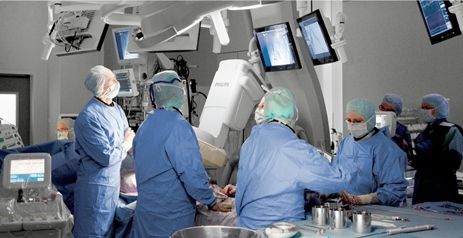The possibilities for the future of minimally invasive procedures through image guided therapy are practically endless. At the moment, we perceive image guided therapy as an enabling diagnostic technology for minimally invasive therapy. But its capabilities won’t end there; there will be smarter therapeutic devices that not only guide treatment through vascular imaging but also deliver the disease therapy – a truly integrated solution in one device.
I envision a time when all surgical procedures in cardiology,
neurology, oncology and even areas like spinal surgery and orthopedics will be
done through minimally invasive treatment, supported by intelligent imaging
systems and devices.

Where are we now?
In the short term, an area showing promising advances is the treatment of hypertension through renal denervation. As you know, hypertension – often referred to as the ‘silent killer’ – is a leading cause of heart disease and stroke. Renal denervation is a novel therapy approved for uncontrolled hypertension. During this minimally invasive procedure, a catheter emits a radio frequency (RF) energy at the intimal wall of the renal artery to ablate the renal nerve that regulates blood pressure. This shows the potential of image guided therapy to provide a solution for the large group of hypertensive patients that do not respond to drug therapy. While renal denervation is still in its infancy, the promise is out there.
Developments like this will create further demand for us to create tailored technologies and devices that improve patients’ outcomes, reducing the burden on the healthcare system.
How can we embrace and deliver the future of image guided therapy?
It is important that we create an environment that enables the adoption of these new clinical procedures so we can deliver on this promising future.
Firstly, we need to develop new technologies and smarter devices that give physicians access to all the relevant information at the point of care. This information then needs to be delivered as seamlessly as possible to help decide the best treatment strategy for each patient. We also need to provide the tools to efficiently guide that treatment and then confirm whether the treatment has been optimally performed.
But technology alone is not enough; for the best outcomes, industry needs to partner with healthcare providers to ensure we are developing solutions that benefit patients. We also need to offer a team of people with the right capabilities and expertise to create optimal workflow environments.
Secondly, we need to ensure new technologies and devices are reconstructed and co-registered with any imaging modality in real time, relieving the need for continuous fluoroscopy and therefore allowing a really strong x-ray dose reduction.
Lastly, as healthcare systems shift to models that focus even more on quality of care, long-term outcomes and outcomes based payment models, the imperative for providing robust clinical evidence of the health and economic benefits of new technologies is increasing. This clinical evidence will drive Guideline change and define appropriate use criteria, which in turn will aid reimbursement across different healthcare systems and ensure the widespread adoption of technological breakthroughs.
For Philips, with the acquisition of Volcano, we are marrying a leader in the systems area with one in the device space. This distinctive move enables us to provide a personalized approach. It means that we will partner with our customers to drive more efficient procedures and better outcomes. It is these unique capabilities that will help us deliver this promising future.
Over time, image guided therapy procedures will ultimately become even more efficient through more intelligent imaging and will lead to lower x-ray dosage. Ranging from peripheral to structural heart disease, as well as neurology and oncology domains, there is a broad spectrum of new procedures that will be made more efficient by image guided therapy. My question to you is this: what do you think the future holds and what needs to be done to achieve it?















